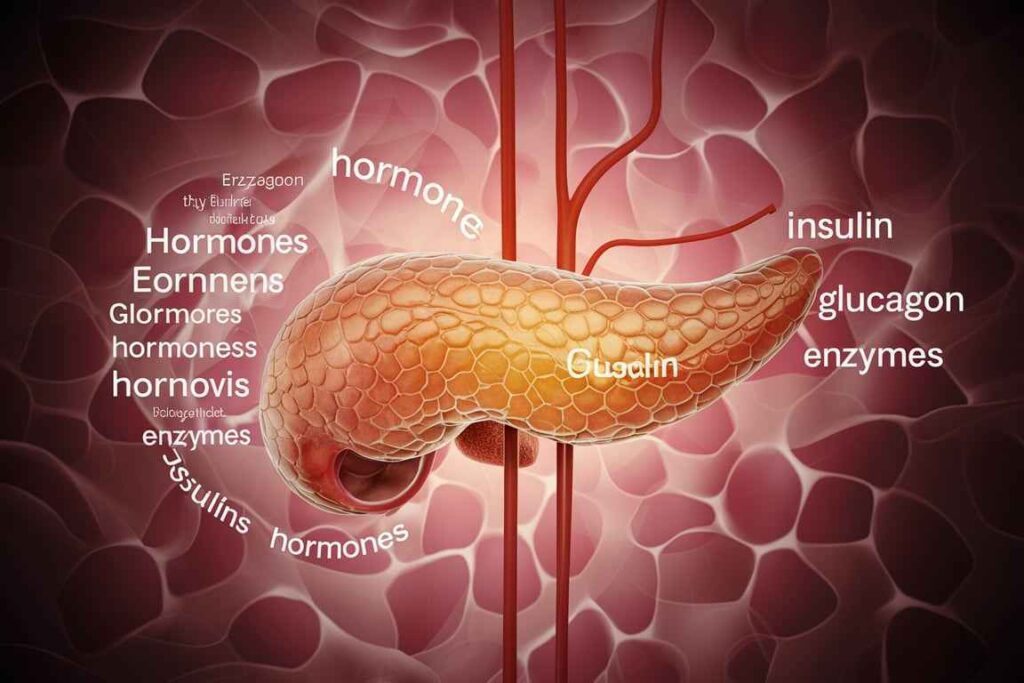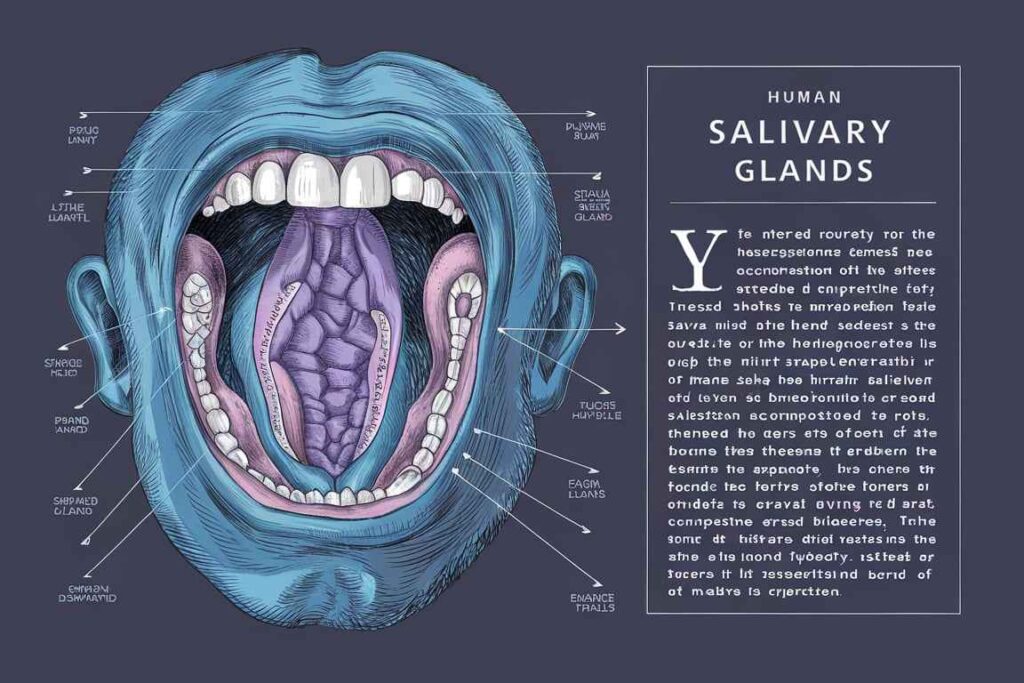Digestive system consists of several glands that secrete various substances to aid in the digestion and absorption of nutrients. Here’s a detailed look at the major digestive glands, their secretions, and their functions. There are several digestive glands in the human digestive system that secrete various substances to aid in the process of digestion.
Table of Contents
Digestive glands
Digestive glands are specialized organs that produce and secrete substances necessary for the digestion of food. These glands play a crucial role in breaking down complex food molecules into simpler forms that can be absorbed and utilized by the body. The substances secreted by digestive glands include enzymes, acids, bile, and mucus, each serving specific functions in the digestive process. There are several digestive glands in the human digestive system that secrete various substances to aid in the process of digestion. These glands include:

1. Salivary Glands:
The salivary glands, located in the mouth, secrete saliva which contains amylase enzyme that helps initiate the breakdown of carbohydrates. Saliva also moistens food to facilitate swallowing.
2. Gastric Glands:
Found in the stomach lining, gastric glands produce gastric juice which consists of hydrochloric acid and enzymes such as pepsinogen and gastric lipase. Hydrochloric acid creates an acidic environment for pepsinogen to convert into its active form called pepsin, which breaks down proteins. Gastric lipase aids in the digestion of fats.
3. Pancreas:
The pancreas secretes pancreatic juice into the small intestine through a duct called the pancreatic duct. Pancreatic juice contains several enzymes including amylase (for carbohydrate digestion), lipase (for fat digestion), and trypsin and chymotrypsin (for protein breakdown). It also neutralizes stomach acid with bicarbonate ions to create a suitable environment for enzyme activity.

4. Liver:
Although not technically a gland, liver plays an important role in digestion by producing bile that is stored and concentrated in the gallbladder before being released into the small intestine upon ingestion of fatty foods. Bile emulsifies fats, breaking them down into smaller droplets for better absorption by enzymes.
5.Intestinal Glands:
There are millions of small intestinal glands present throughout the wall of the small intestine that produce intestinal juice containing various enzymes such as maltase, lactase, sucrase (for carbohydrate breakdown), peptidases (for protein digestion), and enterokinase (activates trypsin). Additionally, goblet cells within these glands secrete mucus for lubrication and protection.
Functions performed by these digestive glands include:
- Breaking down complex carbohydrates into simple sugars
- Breaking down proteins into amino acids
- Breaking down fats into fatty acids and glycerol
- Neutralizing stomach acid to maintain optimal pH levels for enzyme activity
- Facilitating absorption of nutrients from digested food particles
Major Digestive Glands
- Salivary Glands
- Gastric Glands
- Pancreas
- Liver
- Intestinal Glands
1. Salivary Glands

Types:
- Parotid glands
- Submandibular glands
- Sublingual glands
Secretions:
- Saliva: Contains water, electrolytes, mucus, enzymes (amylase), and antibacterial compounds.
Functions:
- Lubrication: Moistens food to aid in chewing and swallowing.
- Digestion: Salivary amylase begins the digestion of carbohydrates by breaking down starch into maltose.
- Protection: Lysozyme and other antimicrobial agents help control bacterial growth in the mouth.
2. Gastric Glands
Location: Lining of the stomach.
Secretions:
Gastric juice, which includes:
- Hydrochloric acid (HCl): Secreted by parietal cells.
- Pepsinogen: Secreted by chief cells.
- Mucus: Secreted by mucous cells.
- Intrinsic factor: Secreted by parietal cells.
Functions:
- Protein Digestion: HCl activates pepsinogen to pepsin, an enzyme that breaks down proteins into peptides.
- Protection: Mucus protects the stomach lining from the acidic environment and digestive enzymes.
- Vitamin B12 Absorption: Intrinsic factor is essential for the absorption of vitamin B12 in the small intestine.
3. Pancreas
Location: Behind the stomach.
Secretions:
Pancreatic juice, which includes:
- Digestive enzymes: Amylase, lipase, proteases (trypsinogen, chymotrypsinogen, procarboxypeptidase).
- Bicarbonate ions: Neutralize the acidic chyme from the stomach.
Functions:
- Carbohydrate Digestion: Pancreatic amylase continues the breakdown of starches into sugars.
- Protein Digestion: Proteases (activated in the small intestine) break down proteins into peptides and amino acids.
- Fat Digestion: Pancreatic lipase breaks down triglycerides into fatty acids and glycerol.
- Neutralization: Bicarbonate neutralizes stomach acid, creating an optimal pH for enzyme activity in the small intestine.
4. Liver
Location: Upper right abdomen, beneath the diaphragm.
Secretions:
- Bile: Stored in the gallbladder and released into the small intestine.
Functions:
- Fat Emulsification: Bile salts emulsify fats, increasing their surface area for the action of pancreatic lipase.
- Waste Excretion: Bile carries waste products, including bilirubin (a byproduct of red blood cell breakdown), out of the body via the digestive tract.
5. Intestinal Glands (Crypts of Lieberkühn)
Location: Lining of the small intestine.
Secretions:
Intestinal juice, which includes:
- Enzymes: Disaccharidases (e.g., maltase, sucrase, lactase), peptidases, nucleotidases.
- Mucus: Lubricates and protects the intestinal lining.
Functions:
- Carbohydrate Digestion: Disaccharidases break down disaccharides into monosaccharides for absorption.
- Protein Digestion: Peptidases further break down peptides into amino acids.
- Nucleotide Digestion: Nucleotidases break down nucleotides into nitrogenous bases, pentose sugars, and phosphate groups.
Frequently Asked Question
What is Digestive glands ?
Digestive glands are specialized organs that produce and secrete substances necessary for the digestion of food. These glands play a crucial role in breaking down complex food molecules into simpler forms that can be absorbed and utilized by the body.
What are the major Digestive Glands?
The major Digestive Glands are
1. Salivary Glands
2. Gastric Glands
3. Pancreas
4. Liver
5. Intestinal Glands
Related Article

